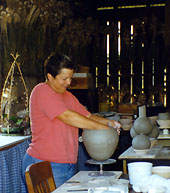
 with Vince Pitelka |
 |
July 18-22, 2011 - ANCIENT CLAY, with Vince
Pitelka. Ferndale, Washington - McDowell Studio/Farm Covers handbuilding techniques, decoration, terra-sigilatta, burnishing/polishing, bonfire-firing of ancient/tribal vessels/sculpture. Beginning through advanced. $300 + clay usage, includes all other materials and firing. $50 non-refundable deposit. On-site camping allowed, or motels nearby, share cost of group-prepared meals. To register, or for more information contact: Michael McDowell P.O.Box 960, Ferndale, WA 98248 Phone - 360/384-2543 Email - michael@mcdowellpottery.com |
|
| PROJECTS | Modeled, pinched, and coil-constructed vessels and sculptural forms with a variety of surface-decoration options including bisque stamps, applique, burnishing, terra sigilatta, polychrome slip painting, and black-on-black brush decoration. | |
| BACKGROUND | In examining the evolution of modern culture, we too often assume that "progress" means a move from un-civilized to civilized, from primitive to sophisticated, from manual to automated, from low-tech to high-tech, from hand-made to machine-made. As a result, artists have often turned their backs on the wonderful aesthetics, processes and techniques of the past. Until quite recently tribal ceramic traditions were generally seen as primitive oddities, like "living ancient history," and were often ignored in the study of ceramics. Fortunately, the appreciation and understanding of ancient and tribal art has increased dramatically, and we now recognize that these traditions are "primitive" only in the tools, facilities, and firing processes, while the level of craftsmanship, the narrative content, and the design aesthetic are highly sophisticated. | |
COURSE
DESCRIPTION: |
This workshop gives beginning and experienced clay-workers the opportunity to investigate the techniques and aesthetics of ancient and tribal ceramics. We will focus on simple vessel construction using pinch and coil methods, exploring the broad diversity of handbuilt form and the range of decorative effects possible without the use of glazes. Slide shows will explore high points in the history of ancient and tribal clay. The work we make will be coated with terra sigillata and finished with ancient and tribal polishing techniques. Traditionally, tribal pottery is fired in a single bonfiring, but this is only possible with a very coarse clay body and a long slow bonfiring. To allow a quick bonfiring and to minimize losses, our wares will be pre-fired in a very low-temperature bisque-fire, and transferred from bisque to bonfire while still warm. The bonfire will be a classic blackware firing, similar to that practiced by Native American potters of the American Southwest and other cultures through history. A major appeal of tribal ceramics is that the processes involve almost no modern technology. This feature is difficult for many modern ceramic artists to accept, with our fascination for tools and equipment. Once experienced, however, a tribal approach to ceramics is tremendously liberating, even for contemporary "high-tech" ceramic artists. |
|
WORKSHOP SUPPLIES TO
BRING:
|
|
|
WORKSHOP
SCHEDULE:  |
MONDAY MORNING - Introductions, discussion/demo of coil-construction, use of pukis. Work on coil forms. Slide discussion on ancient and tribal clay. MONDAY AFTERNOON - Demo of pinch construction and slumped-slab masks. Continue slide discussion on ancient and tribal clay. Work on pinch/coil forms and masks. TUESDAY MORNING - discussion/demo of whistles and rattles, damp clay decoration. Work on pinch/coil forms and masks. Slide discussion on ancient and tribal clay. TUESDAY AFTERNOON - Finish coil forms and masks. Work on pinch forms and whistles. Load coil forms and masks in kiln to dry overnight. WEDNESDAY MORNING - Finish any remaining coil forms and masks and quick-dry in kilns. Slide discussion on figurines and amulets. Work on pinch forms, whistles, figurines, and amulets. WEDNESDAY AFTERNOON - Sanding demo. Sand all coil forms and masks. Finish pinch forms, whistles, figurines, and amulets. WEDNESDAY AFTERNOON OR EVENING - Slide show on Vince's work. THURSDAY MORNING - Discussion/demo of terra sigillata, polishing, burnishing, sgraffito, black- on-black. Work on sanding, terra sigillata, polishing, decorating. THURSDAY AFTERNOON - Complete all polishing/decorating, load bisque firings. Prepare for bonfire-firing. FRIDAY MORNING - The big bonfire. Slide show on ancient/tribal firing processes. FRIDAY AFTERNOON - Dig up bonfire and admire the work. |
|
 |
||
| Return to Workshops Page | Return to Michael McDowell's Homepage | ||
| These photos are copyrighted by Kayo Parsons-Korn. You may copy them for yourself but any duplication for commercial purposes in any form is prohibited. The electronic image and text presentation of the artist on the Internet does not waive any of the normal protections under copyright law. If you wish to use an image or refer to this webpage, please contact Michael McDowell at michael@mcdowellpottery.com. | ||
| Web Design by Kayo Parsons-Korn Design |